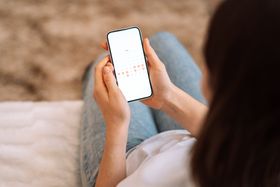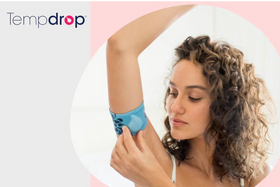Tempdrop vs. Daysy Fertility Trackers: Which Is Best for You?
Published July 18, 2023.

You may have heard of the "fertility window," which is the time in your menstruation cycle when conception is most likely if you're trying to fall pregnant. This typically encompasses the 5 days before you ovulate, the day of ovulation, and the day following ovulation—7 days altogether.
But ovulation happens at different times for everyone, and even at different times for the same person in different cycles. Tracking your cycle, including basal body temperature (BBT), gives you insight into your fertility, which allows you to time intercourse so you can improve your chances of pregnancy.
There are plenty of devices out there that claim to be the best or most convenient way to track your cycle. To help you choose the tool that's most suitable for you and your fertility goals, let's compare Tempdrop with the Daysy fertility tracker.
Tempdrop vs. Daysy at a Glance
| | Tempdrop | Daysy |
|---|---|---|
| User Experience | Worn on the upper arm while you sleep | Place thermometer under your tongue first thing when you wake up before getting up |
| Main Features | Continuously tracks temperature throughout the night while you sleep In-app cycle and fertility tracking Sleep tracking | Uses a self-learning algorithm to take your temperature Takes your temperature, stores your data, and calculates your fertility from a single device Color-coded lights to indicate different cycle phases |
| Fertile Window Interpretation | Option to use fertility predictions or turn them off to interpret your own data | Daysy takes 2-4 cycles as a learning phase. Then, you will see more green lights around your fertile window. The more you measure, the more accurate the results |
| Suitable for Irregular Cycles or Changing Sleep Patterns | Yes | Yes, but if your ovulation fluctuates by more than 4 days or your cycle length is outside the 19-40 day range, it's recommended to contact Daysy's experts |
| FDA Regulation | FDA registered | FDA registered |
| Price | $215 | $319 |
| Insurance Coverage | HSA + FSA eligible | HSA + FSA eligible |
Tempdrop Fertility Tracker
You may be wondering, "What is Tempdrop?" It's an overnight wearable BBT sensor that helps track ovulation. It just has to be turned on for at least 3 hours while wearing it to get enough data to determine what your resting temperature is.
How does Tempdrop work and give you that temperature?
When you wake and remove the device, you sync it with the Tempdrop app, which runs numerous data points through an algorithm that determines your temperature and sleep motions.
Pros
- Can use any fertility awareness method
- No strict waking time
- Free app with manual interpretation
- Fertility charting available in app
- Great for those who work rotating shifts
Cons
- Requires armband to be worn overnight
- Not everyone is comfortable having their data tracked in an app
Daysy Fertility Tracker
The Daysy thermometer requires that you manually take your temperature each morning. It gives you the flexibility to take your temperature at whatever time you wake up.
Once it has this data, it requires a learning phase to get to know your unique cycle. It displays a red light to indicate fertility or a green light to indicate infertility. It can also predict your ovulation day (red flashing light) and potential pregnancy (red, green, and yellow blinking lights).
Pros
- Flexibility in BBT time
- Easy to use
- Daysy partner app
Cons
- App is buggy
- Daysy-funded studies with selection bias
- Temperature has to be taken manually
- Costly
Tempdrop vs. Daysy: User Experience
How to wear/use Tempdrop?
The Tempdrop armband is worn on your arm near your armpit (over the axillary artery). Ensure the device is on before going to sleep. In the morning, remove it from your arm. At your convenience, you then Bluetooth sync it with Tempdrop's app. You can keep your data in Tempdrop's app or export it to your favorite charting app.
How to wear/use Daysy?
Daysy is a BBT thermometer that you use each morning when you wake up. It sends the data to your phone, and then tells you your fertility status. It gives you a simple light indicator: red for fertile/possibly fertile and green for infertile.
Tempdrop vs. Daysy: Main Features
Both devices allow users to track BBT as well as other fertility factors, like ovulation. This helps identify when users are most fertile.
Tempdrop learns the more it's used to give you a more accurate overview of your temperature, sleep patterns, and other fertility factors—even if your cycle and sleep are irregular. Personally, I like that Tempdrop lets you choose what sorts of risks to take into account because you can easily follow what the data means for your health and fertility goals.
Daysy does all of the work of tracking your cycle and giving you a fertility status daily. But because Daysy relies at least partly on past cycles, it has to be more conservative in the case of irregular cycles and labels more days as potentially fertile than a specific fertility awareness method may determine.
Winner: Tempdrop
Tempdrop vs. Daysy: Price
Is Tempdrop worth it?
Tempdrop starts at $215 and has optional additional costs of $40 for a 12-month refund and extended warranty and $89 for a 1-year insurance policy. Tempdrop is also HSA and FSA eligible.
Is Daysy worth it?
The Daysy thermometer cost ranges from $319 to $546 and is HSA and FSA eligible. The higher-priced options are packages that include educational materials. The Daysy fertility tracker is covered by insurance, depending on your policy, and you get a 2-year warranty with your purchase.
Winner: Tempdrop
Which Is Better Overall?
For me, Tempdrop is overall a more suitable option. I prefer its flexibility when it comes to analyzing and viewing your data to take your fertility and health goals into your own hands. Tempdrop also uses daily data to accurately interpret your cycle within 2 weeks, as opposed to Daysy's two-cycle learning phase, which can give incorrect readings.





